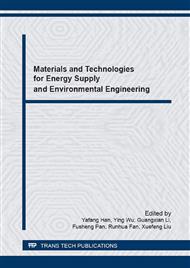[1]
Jing Wei, Qing Zhao, Heng Li, Chenglong Shi, Jianjun Tian, Guozhong Cao, Dapeng Yu. Perovskite solar cells: Promise of photovoltaics (in Chinese). Sci Sin Tech, 2014, 44: 801–821.
DOI: 10.1360/n092014-00135
Google Scholar
[2]
Nam Joong Jeon, Jun Hong Noh, Woon Seok Yang, Young Chan Kim, Seung chan, Ryu Jangwon Seo, Sang II Seok. Compositional engineering of perovskite materials for high-performance solar cells, Nature 517, 476–480 (22 January 2015).
DOI: 10.1038/nature14133
Google Scholar
[3]
Hui Yu, Feng Wang, Fangyan Xie, Wenwu Li, Jian Chen and Ni Zhao. The Role of Chlorine in the Formation Process of CH3NH3PbI3-xClx, Perovskite. Materials Science.
Google Scholar
[4]
BAI Xiao-Gong, SHI Yan-Tao, WANG Kai, DONG Qing-Shun, XING Yu-Jin, ZHANG Hong, WANG Liang, MA Ting-Li. Synthesis of CH3NH3SrxPb(1-x)I3 with Less Pb Content and Its Application in All-Solid Thin Film Solar Cells. Acta Phys. Chim. Sin, 2015, 31(2): 285-290.
Google Scholar
[5]
Huanping Zhou, Qi Chen, Gang Li, Song Luo, Tze-bing Song, Hsin-Sheng Duan, Ziruo Hong, Jingbi You, Yongsheng Liu, Yang Yang. Interface engineering of highly efficient perovskite solar cells. Science Magazine. Science 1 August (2014).
DOI: 10.1126/science.1254050
Google Scholar
[6]
Eran Edri, Saar Kirmayer, Sabyasachi Mukhopadhyay, Konstantin Gartsman, Gary Hodes & David Cahen. Elucidating the charge carrier separation and working mechanism of CH3NH3PbI3−xClxperovskite solar cells. Nature Communications 5, Article number: 3461.
DOI: 10.1038/ncomms4461
Google Scholar
[7]
Michele De Bastiani, Valerio D'Innocenzo, Samuel D. Stranks, Henry J. Snaith and Annamaria Petrozza, Role of the crystallization substrate on the photoluminescence properties of organo-lead mixed halides perovskites. APL Mat. 2, 081509 (2014).
DOI: 10.1063/1.4889845
Google Scholar
[8]
Min-Cherl Jung, Sonia R. Raga, Luis K. Ono & Yabing Qi. Substantial improvement of perovskite solar cells stability by pinhole-free hole transport layer with doping engineering. Scientific Reports 5, Article number: 9863.
DOI: 10.1038/srep09863
Google Scholar
[9]
Wan-Jian Yin, Yanfa Yan, and Su-Huai Wei. Anomalous Alloy Properties in Mixed Halide Perovskites. J. Phys. Chem. Lett., 2014, 5 (21), p.3625–3631.
DOI: 10.1021/jz501896w
Google Scholar
[10]
Nakita K. Noel, Samuel D. Stranks, Antonio Abate, Christian Wehrenfennig, Simone Guarnera, Amir-Abbas Haghighirad, Aditya Sadhanala, Giles E. Eperon, Sandeep K. Pathak, Michael B. Johnston, AnnamariaPetrozza, Laura M. Herz and Henry J. Snaith. Lead-free organic–inorganic tin halide perovskites for photovoltaic applications. Energy Environ. Sci., 2014, 7, 3061-3068.
DOI: 10.1039/c4ee01076k
Google Scholar


